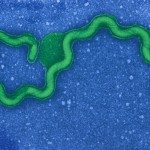Lien vers Pubmed [PMID] – 32106244
Lien DOI – 10.1371/journal.pone.0229673
PLoS ONE 2020 ; 15(2): e0229673
Leptospirosis is a neglected disease causing severe infections in humans and animals. Due in part to misdiagnosis, this infectious disease results in nearly 60,000 deaths per year around the globe. This study represents the first effort to describe the diversity of pathogenic Leptospira in Cuba based on whole-genome sequencing. We have collected nineteen whole-blood samples from patients that were diagnosed as having leptospirosis between 2008 and 2012 in Cuba. In addition, we have enhanced our sample set by three historical strains that were used for the development of a human vaccine in 1990s. The Leptospira strains were grown and serotyped by the microscopic agglutination test, and the draft genomes were generated by NGS (Illumina). Subsequently, the core genomes were analyzed and compared to the genetic data available from other Caribbean islands and countries in Central America. Core genome Multi-locus Sequence Typing (cgMLST) revealed four different core genome clonal groups (cgCGs), with the highest number of samples belonging to L. interrogans, followed by L. borgpetersenii and L. kirschneri. All cgCGs that were found in Cuba have been also identified from multiple origins across the globe, except in neighbor countries and Central America. Serotyping divided the samples into the serogroups Canicola, Ballum and Pomona. The most frequent cgCGs, cgCG28, associated with serogroup Canicola, and cgCG15, associated with serogroup Ballum, have also been identified from samples isolated from dogs, rodents, and pigs; suggesting that these hosts represent the major source of human infection in Cuba. The vaccine strains did not significantly differ from the recent patient isolates. However, the increasing prevalence of samples belonging to the serogroup Ballum combined with the fact that the available vaccine in Cuba represents inactivated Leptospira belonging to serogroups other than Ballum, should be a valuable information for the National and Regional Leptospirosis Control Programs.

